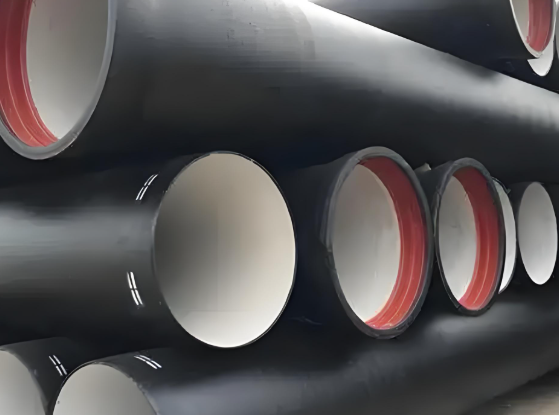Ductile iron pipes are essential components in water and wastewater infrastructure due to their strength, durability, and resistance to corrosion. The manufacturing process involves several key steps to transform raw materials into high-quality pipes.

1. Raw Material Selection
The process begins with selecting high-quality pig iron, scrap iron, and other alloying elements. These materials are carefully chosen to achieve the desired chemical composition and mechanical properties in the final product.
2. Melting and Alloying
The selected materials are melted in a blast furnace or an electric arc furnace. During this stage, elements like carbon, silicon, and magnesium are added to the molten iron to achieve the desired composition. Magnesium is particularly crucial as it promotes the formation of nodular graphite, giving ductile iron its characteristic strength and flexibility.
3. Centrifugal Casting
The molten iron is poured into rotating molds in a process known as centrifugal casting. As the mold spins, the centrifugal force distributes the molten iron evenly, forming a dense and uniform pipe wall. This technique ensures the pipe’s strength and uniformity.
4. Cooling and Solidification
After casting, the pipes are allowed to cool and solidify. The cooling rate is carefully controlled to ensure the proper formation of the microstructure, which is essential for the pipe’s mechanical properties.
5. Heat Treatment
The solidified pipes undergo heat treatment processes, such as annealing, to relieve internal stresses and enhance their mechanical properties. This step ensures the pipes achieve the desired hardness and ductility.
6. Cutting and Finishing
Once heat-treated, the pipes are cut to the required lengths. The ends of the pipes are machined to create bell-and-spigot joints or flanged ends, depending on the intended application.
7. Surface Coating
To protect against corrosion, the pipes are coated with materials such as cement mortar, epoxy, or polyethylene. These coatings provide a protective barrier against environmental factors and extend the pipe’s service life.
8. Quality Control and Inspection
Each pipe undergoes rigorous quality control measures, including visual inspections, dimensional checks, and mechanical property testing. Advanced techniques like ultrasonic testing and X-ray inspection may also be used to detect any internal defects.
🧪 Benefits of Ductile Iron Pipes
| Benefit | Description |
|---|---|
| High Strength | Resistant to internal and external pressures, making them ideal for water systems. |
| Corrosion Resistance | Protective coatings and alloying elements enhance resistance to corrosion. |
| Durability | Long service life, often exceeding 100 years with proper maintenance. |
| Flexibility | Ability to withstand ground movements and external loads without cracking. |
| Recyclability | Made from recyclable materials, contributing to environmental sustainability. |
❓ Frequently Asked Questions (FAQs)
Q1: What is the difference between ductile iron and cast iron pipes?
Ductile iron pipes are made from ductile iron, which contains nodular graphite, providing enhanced strength and flexibility compared to traditional cast iron pipes.
Q2: How long do ductile iron pipes last?
With proper installation and maintenance, ductile iron pipes can last over 100 years.
Q3: Are ductile iron pipes environmentally friendly?
Yes, ductile iron pipes are made from recyclable materials and have a long service life, reducing the need for frequent replacements.
Q4: Can ductile iron pipes be used for both water and wastewater systems?
Yes, ductile iron pipes are suitable for both potable water and wastewater applications due to their strength and corrosion resistance.
📽️ Visual Guide
For a detailed visual representation of the ductile iron pipe manufacturing process, watch the following video:
🏁 Conclusion
The manufacturing of ductile iron pipes involves a meticulous process that ensures the production of durable, reliable, and environmentally friendly pipes. From raw material selection to final inspection, each step is crucial in delivering a product that meets the stringent requirements of modern infrastructure projects.
References:
- Ductile Iron – Wikipedia
- AWWA C151: Ductile-Iron Pipe, Centrifugally Cast, for Water – American Water Works Association (AWWA)
- ASTM A536 Standard Specification for Ductile Iron Castings – ASTM International
- Assessment of Water Infrastructure Materials and Their Longevity – National Academies Press
- Ductile Iron Pipe Manufacturing and Corrosion Protection – Corrosionpedia
